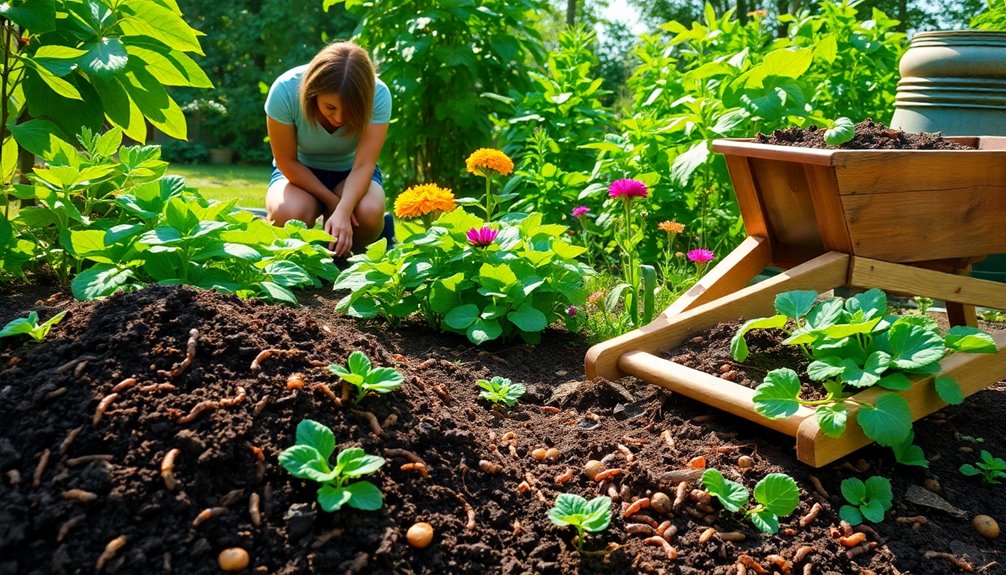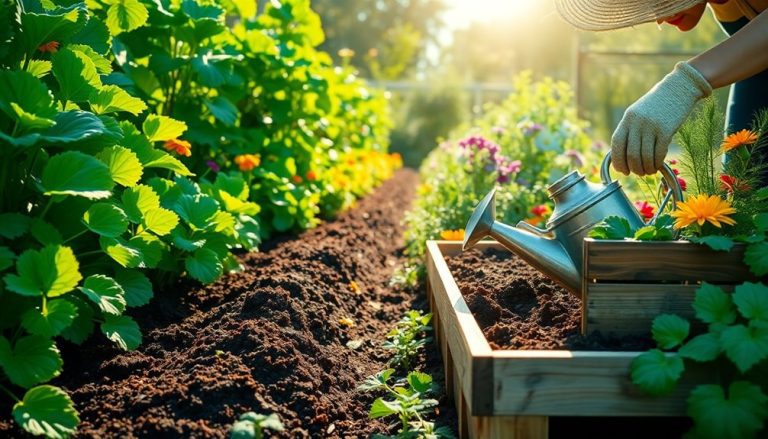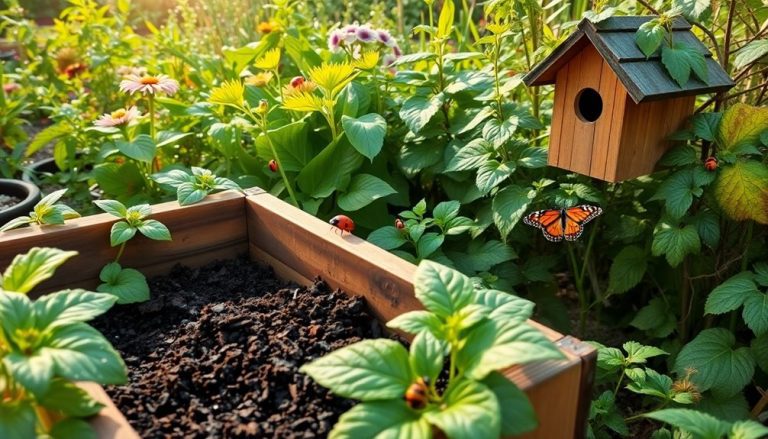To improve your garden's soil health organically, start by adding organic matter like compost or manure. This boosts nutrients and promotes beneficial microorganisms. Rotate your crops every few years to prevent soil depletion and enhance fertility. Incorporate cover crops, like clover, to improve soil structure and nutrient levels during off-seasons. Don't forget to mulch; it helps retain moisture and suppress weeds. Regularly check and manage your soil's pH for optimal growth, and observe conditions for signs of deficiency. There's much more to discover about nurturing your soil and plants effectively.
Key Takeaways
- Incorporate organic matter like compost and manure regularly to enhance nutrient levels and soil structure for better plant growth.
- Practice crop rotation every three to four years to prevent soil depletion and improve fertility by alternating nutrient profiles.
- Use mulch, such as wood chips or grass clippings, to retain moisture, suppress weeds, and improve soil structure over time.
- Monitor soil pH levels with testing kits, adjusting as necessary to maintain an ideal range of 6.0 to 7.0 for optimal nutrient absorption.
- Encourage beneficial microorganisms by avoiding chemical fertilizers, which helps enhance nutrient availability and promote healthy soil ecosystems.
Understanding Soil Health
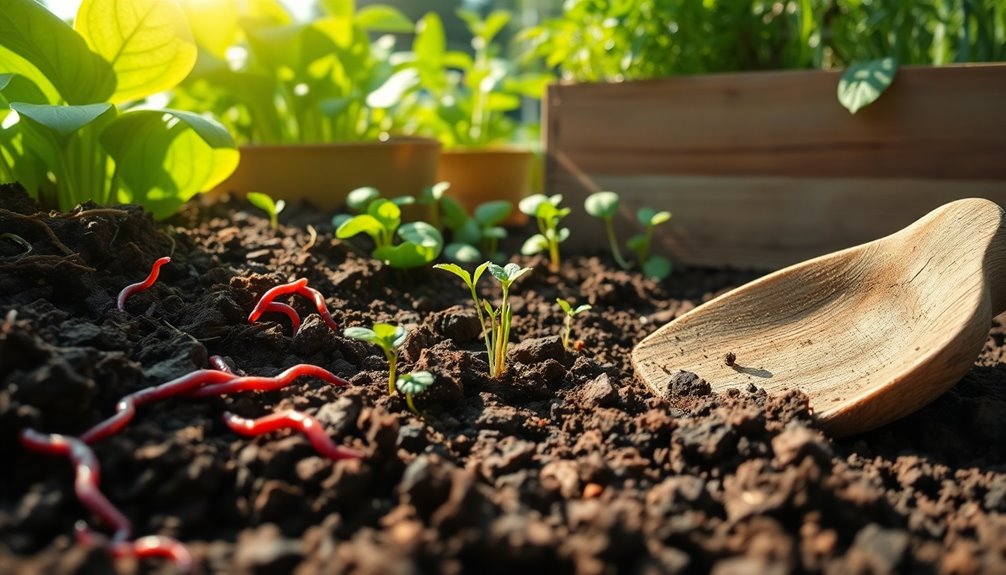
Soil health is crucial for thriving ecosystems and productive gardens, and it encompasses various factors that contribute to soil's vitality. To understand soil health, you need to consider its physical, chemical, and biological properties.
Healthy soil has a good structure, allowing water and air to flow freely. When soil's structure is compromised, it can lead to compaction, which limits root growth and water absorption.
Next, think about soil's chemical properties. Essential nutrients like nitrogen, phosphorus, and potassium must be present in the right amounts for plants to thrive. Soil pH also plays a vital role, affecting nutrient availability. You can test your soil to determine its nutrient levels and pH, enabling you to make informed decisions on amendments.
Finally, don't overlook the biological aspect of soil health. A diverse community of microorganisms and earthworms contributes to nutrient cycling and organic matter breakdown.
Healthy soil teems with life, which helps maintain balance. By understanding these components, you'll be better equipped to nurture your garden and improve soil health organically, fostering a thriving environment for your plants to flourish.
Benefits of Organic Soil Amendments
When you choose organic soil amendments, you're not just enhancing nutrient levels; you're also boosting the overall health of your garden ecosystem.
These amendments improve soil structure, making it easier for roots to grow and access water. They promote beneficial microbial activity, which is essential for breaking down organic matter and releasing nutrients.
Using organic materials, like compost or well-rotted manure, helps increase soil fertility over time. This gradual release of nutrients ensures your plants receive a steady supply, reducing the risk of nutrient leaching and runoff.
Plus, organic amendments can help balance soil pH, creating an optimal environment for your plants to thrive.
Another major benefit is improved moisture retention. Organic matter can hold water much better than synthetic fertilizers, meaning your plants will need less frequent watering, especially during dry spells.
Additionally, organic amendments can suppress weeds and pests naturally, reducing your reliance on chemical treatments.
Adding Organic Matter
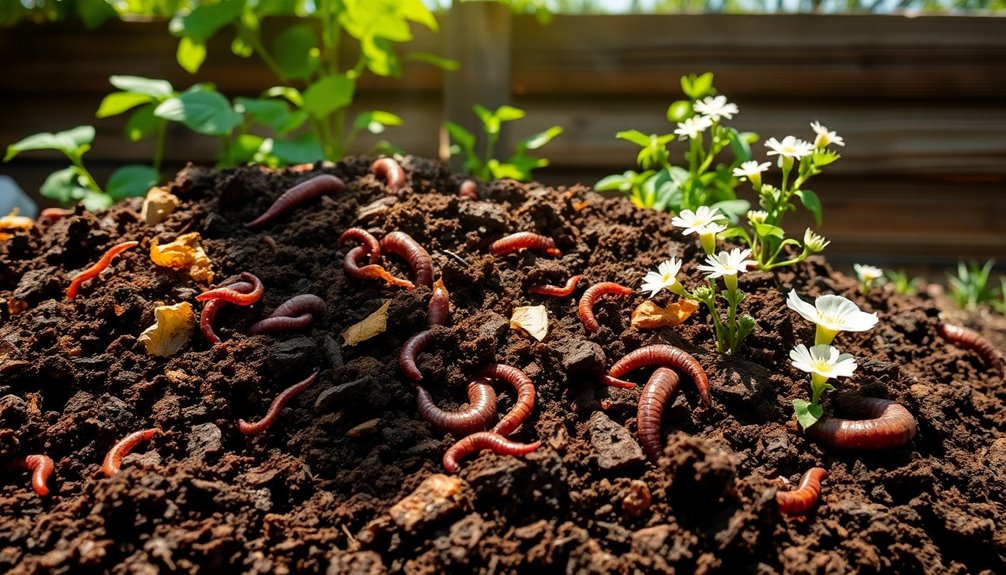
To truly enhance your garden's health, adding organic matter is a game changer. It improves soil structure, boosts nutrient availability, and fosters beneficial microorganisms.
By incorporating organic matter, you create a thriving ecosystem for your plants. Here are three effective ways to add organic matter to your garden:
- Compost: Start a compost pile with kitchen scraps, yard waste, and other organic materials. Once it's decomposed, mix it into your garden beds for a nutrient-rich boost.
- Mulch: Apply a layer of organic mulch, like straw, wood chips, or shredded leaves, on top of your soil. This helps retain moisture, suppress weeds, and gradually breaks down to enrich the soil.
- Green Manures/Cover Crops: Plant cover crops, such as clover or rye, during the off-season. When you till them back into the soil, they provide nutrients and improve soil structure.
Incorporating these organic materials not only enriches your soil but also contributes to a more sustainable gardening approach. Additionally, investing in a quality compost bin can streamline the composting process and enhance your garden's productivity.
Start today, and watch your garden thrive!
Practicing Crop Rotation
Crop rotation is a vital practice for maintaining a healthy garden ecosystem. By alternating the types of crops you grow in specific areas of your garden each season, you can prevent soil depletion, reduce pest and disease buildup, and enhance soil fertility. This method encourages a diverse range of nutrients in your soil, benefiting your plants.
Here's a simple table to help you understand some common crops and their ideal rotation partners:
| Crop Type | Ideal Successor | Benefits |
|---|---|---|
| Legumes | Brassicas | Fix nitrogen in soil |
| Brassicas | Root Vegetables | Deters pests |
| Root Vegetables | Leafy Greens | Improves soil structure |
| Nightshades | Legumes | Breaks disease cycles |
When practicing crop rotation, aim for a three to four-year cycle. This strategy not only keeps your garden vibrant but also minimizes the need for chemical fertilizers and pesticides. So, plan your garden layout accordingly, and enjoy the benefits of healthier soil and more robust plants!
Implementing Cover Crops
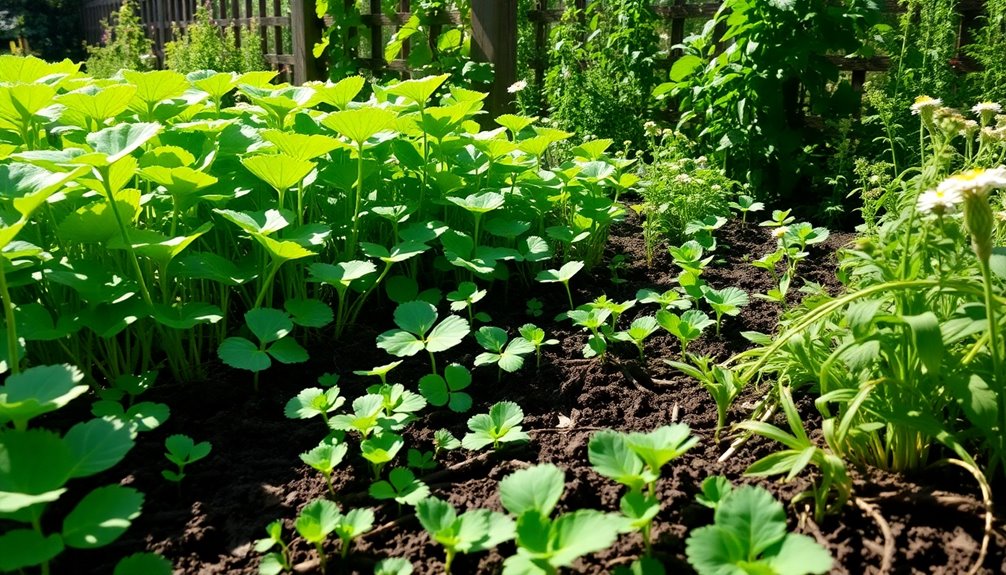
After you've established a solid rotation plan for your crops, consider incorporating cover crops into your gardening strategy. Cover crops are an excellent way to enhance soil health while preventing erosion and suppressing weeds. They're essentially plants you grow between your main crops, and they offer numerous benefits.
- Nutrient Fixation: Leguminous cover crops, like clover or vetch, can fix nitrogen from the atmosphere into the soil, enriching it for future crops.
- Soil Structure Improvement: The roots of cover crops help to break up compacted soil, improving aeration and water infiltration. This creates a better environment for your main crops.
- Weed Suppression: By planting cover crops, you can create a natural barrier against weeds, reducing the need for chemical herbicides and allowing your garden to thrive more organically.
When choosing cover crops, consider your gardening goals and the specific needs of your soil.
Make sure to terminate your cover crops at the right time to maximize their benefits, and you'll see the positive impact on your garden over time.
Happy gardening!
Encouraging Beneficial Microorganisms
Encouraging beneficial microorganisms in your soil is essential for promoting a healthy ecosystem that supports plant growth. These tiny allies break down organic matter, enhance nutrient availability, and improve soil structure.
To foster their presence, start by adding organic matter like compost or well-rotted manure. This provides food and a habitat for these microorganisms.
You can also diversify your soil by planting a variety of crops. Different plants attract different microorganisms, creating a rich, balanced community. Try rotating your crops each season to prevent any one type of microorganism from dominating.
Another effective way to boost microbial activity is to avoid using chemical fertilizers and pesticides. These substances can harm beneficial organisms, disrupting the natural balance. Instead, opt for organic amendments and pest control methods that promote overall soil health.
Finally, consider using mycorrhizal fungi, which form symbiotic relationships with plant roots. These fungi can greatly enhance nutrient uptake and improve your plants' resilience to stress. Additionally, investing in quality soil products can provide a strong foundation for supporting these beneficial microorganisms.
Mulching for Moisture Retention

Mulching is one of the best strategies for retaining moisture in your garden soil. By covering the soil with organic materials, you create a barrier that reduces evaporation and keeps the ground cooler.
This means your plants have a better chance of thriving, especially during hot or dry spells. Here are three effective mulching options you can use:
- Straw or Hay: These materials break down over time, adding nutrients to the soil while providing excellent moisture retention.
- Wood Chips or Bark: They last longer than other mulches and suppress weeds effectively. Just be cautious with the type of wood, as some can rob nitrogen from the soil during decomposition.
- Grass Clippings: When you mow, use the clippings as mulch. They decompose quickly, enriching the soil, but be sure to let them dry first to prevent matting. Additionally, using the right type of mulch products can further enhance your garden's moisture retention capabilities.
Managing Soil Ph Levels
Maintaining balanced soil pH levels is crucial for healthy plant growth. A pH level between 6.0 and 7.0 is generally ideal for most garden plants, allowing them to absorb nutrients effectively. If your soil is too acidic or alkaline, it can hinder nutrient availability and lead to poor plant health.
To manage soil pH, start by testing it with a simple soil test kit. Once you know your soil's pH, you can amend it accordingly. Here's a quick reference table for adjusting pH levels:
| pH Level | Amendment |
|---|---|
| Below 6.0 | Lime (to raise pH) |
| 6.0-7.0 | Ideal (no amendments) |
| Above 7.0 | Sulfur or peat moss (to lower pH) |
Adding organic matter like compost can also help stabilize pH levels over time. Regularly check your soil's pH and make adjustments as needed to keep your plants thriving. By actively managing soil pH, you'll create a more conducive environment for growth, ensuring your garden flourishes throughout the seasons.
Utilizing Composting Techniques
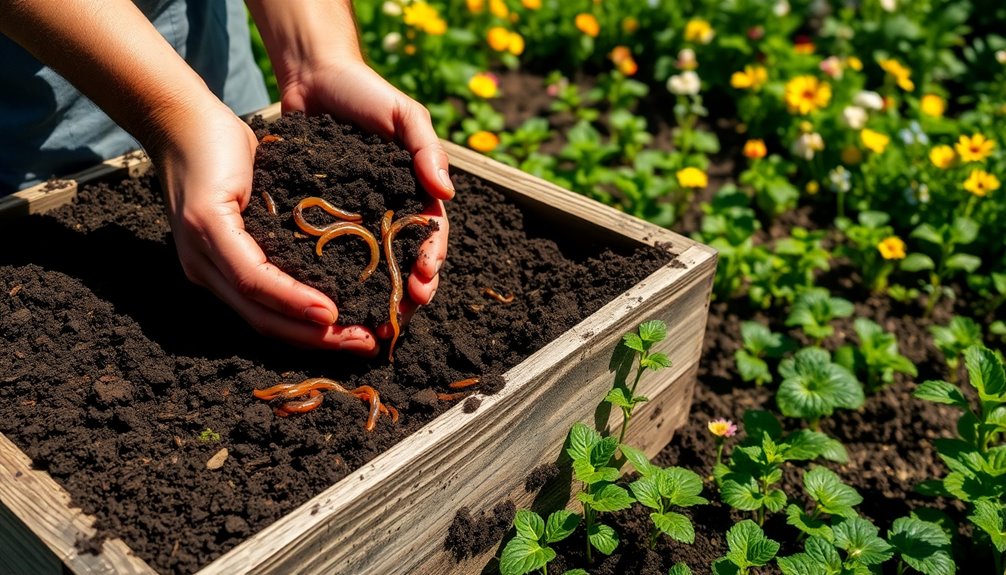
Composting offers a sustainable way to enrich your soil while reducing waste. By turning organic materials into nutrient-rich compost, you're not only improving soil health but also minimizing landfill contributions.
Here are a few techniques to get you started with composting:
- Choose the Right Materials: Use a mix of greens (like vegetable scraps and grass clippings) and browns (such as dried leaves and cardboard). This balance is crucial for effective decomposition.
- Maintain Proper Aeration: Turn your compost pile regularly to introduce oxygen. This promotes faster breakdown and prevents odors. You should aim to turn it every few weeks, keeping it well-aerated.
- Monitor Moisture Levels: Your compost should be damp, not soggy. If it's too dry, add water; if it's too wet, mix in more browns to absorb excess moisture.
Observing and Adjusting Soil Conditions
After you've established a healthy compost system, the next step is to actively observe and adjust your soil conditions. Regularly check your soil's texture and moisture levels. You can do this by grabbing a handful of soil; it should feel crumbly and hold together without being overly wet.
If it's too compact or sticky, consider adding more organic matter to improve its structure.
Look out for signs of nutrient deficiencies in your plants, like yellowing leaves or stunted growth. If you notice these symptoms, test your soil for pH and nutrient levels. You can use a simple soil test kit from your local garden center.
Based on the results, you might need to amend your soil with additional organic fertilizers, like bone meal or fish emulsion, to restore balance.
Pay attention to the microbial activity in your soil, too. Healthy soil teems with life, so if you don't see earthworms or other beneficial organisms, it's time to reassess your practices.
Frequently Asked Questions
How Long Does It Take to See Improvements in Soil Health?
You'll typically notice improvements in soil health within a few months, but significant changes might take a year or more. Factors like climate, soil type, and your practices influence how quickly you'll see results.
Can I Use Kitchen Scraps in My Garden Soil?
Yes, you can definitely use kitchen scraps in your garden soil! Just compost them properly to enrich your soil with nutrients and improve its structure. You'll notice healthier plants and better growth over time.
What Are Signs of Unhealthy Soil?
You'll notice signs of unhealthy soil when plants struggle to grow, exhibit stunted growth, or show yellowing leaves. Additionally, poor drainage, compacted texture, and a lack of earthworms can indicate your soil needs attention.
How Often Should I Test My Soil's Health?
You should test your soil's health every one to three years, depending on your plants' needs and environmental changes. Regular testing helps you identify nutrient levels and any necessary amendments to keep your soil thriving.
Are There Specific Plants That Improve Soil Health?
Yes, certain plants can enhance soil health. You might consider growing legumes, like clover or beans, which fix nitrogen. Deep-rooted plants, like comfrey, also improve soil structure by breaking up compacted layers.
Conclusion
Improving your garden's soil health organically isn't just a theory—it's a journey you can embark on. By embracing practices like adding organic matter, rotating crops, and utilizing composting techniques, you're nurturing a thriving ecosystem. Each step you take enhances not only the soil but also the plants that grow in it. So, dive in, observe the changes, and adjust as needed. Your garden's vitality will reflect your efforts, proving that organic methods truly make a difference.

